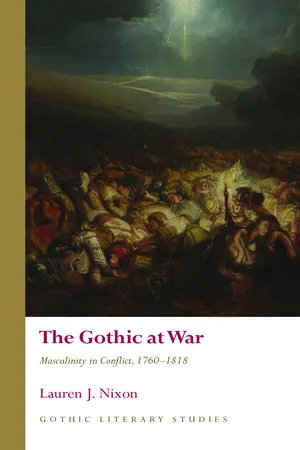
- 272 pages
- English
- ePUB (mobile friendly)
- Available on iOS & Android
About this book
This is an in depth exploration of how the Gothic literature boom of the late-eighteenth century was a response and reaction to the expansion of the British empire, and to the continued periods of war in the second half of the century. The Gothic has often been discussed in relation to the French Revolution as a literature of terror, but The Gothic at War demonstrates how the works of Gothic writers such as Horace Walpole, Charlotte Smith and Ann Radcliffe were also a literature of conflict. This study places a particular focus on masculinity and national identity, analysing how the representations of war and the figure of the soldier in the Gothic of the era allowed women writers in particular to explore anxieties about manliness and nationality.
Frequently asked questions
- Essential is ideal for learners and professionals who enjoy exploring a wide range of subjects. Access the Essential Library with 800,000+ trusted titles and best-sellers across business, personal growth, and the humanities. Includes unlimited reading time and Standard Read Aloud voice.
- Complete: Perfect for advanced learners and researchers needing full, unrestricted access. Unlock 1.4M+ books across hundreds of subjects, including academic and specialized titles. The Complete Plan also includes advanced features like Premium Read Aloud and Research Assistant.
Please note we cannot support devices running on iOS 13 and Android 7 or earlier. Learn more about using the app.
Information
Table of contents
- Cover
- Title Page
- Copyright Page
- Contents
- Acknowledgements
- Introduction: Reclaiming Ancient Glories?: Military masculinity and the rise of the Gothic
- 1 ‘His gallant and indefatigable behaviour’: Horace Walpole, Henry Seymour Conway, and finding the soldier in The Castle of Otranto
- 2 Champions of Virtue: Effeminacy, chivalry and national virtue in Clara Reeve’s The Old English Baron
- 3 ‘That which is right’: Fashioning the soldier as hero in the early works of Ann Radcliffe
- 4 ‘Tinsel ornaments’: Revolution, Gothic realties, and Charlotte Smith’s anti-war novels
- 5 ‘He is just what a young man ought [not] to be’: Anxiety, conflict and failed masculinity in Ann Radcliffe’s The Mysteries of Udolpho
- 6 ‘I am not what I am’: Fractured masculinities and female distress in The Midnight Bell and Clermont
- Conclusion: ‘This comes of the peace’: War and the Gothic beyond the Napoleonic
- Notes
- Bibliography